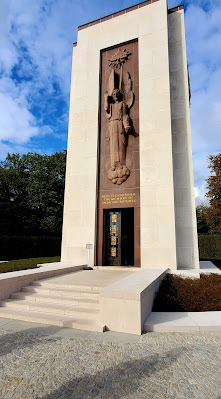The ship stayed docked in Trier overnight. Our plan for this day is to take the optional tour to Luxembourg, a country which we have never traveled.
As we wait for the coach bus that we will take to Luxembourg City, we take a few photos of the early morning fog on the vineyards and the river.
We have a little over 2 hour ride to Luxembourg City. So, a rest stop is provided for us at a truck stop enroute. Here we must pay to use the facilities. Not uncommon in Europe.
Inside the truck stop there is just about anything one would like to buy as they travel.
There is even a laundromat outside.Soon we reach Luxembourg City and Manuela introduces us to our local guide, Maria.
First thing Maria points out is the Monument of Remembrance, or Gelle Fra (Golden Lady).
We only see her from afar, but she overlooks the city from Constitution Square. She was set up in 1923 to commemorate the Luxembourgers who perished in WWI. The Nazis pulled her down in 1940. She was restored and back up in 1984.
Today she symbolizes freedom and resistance for the Luxembourg people.
Notre-Dame Cathedral is the Roman Catholic Cathedral of Luxembourg. It was originally a Jesuit church built in 1613.
On the opposite side of Notre-Dame is the statue of Princess Charlotte. She reigned as Grand Duchess of Luxembourg from January 1919 until her abdication in November 1964.
Her reign saw the evolution of Luxembourg into a modern social-democratic state.
We then walk by the Palais of the Grand Duke of Luxembourg right in the core of the Old Town. It is the official residence of the Grand Duke and where he performs most of his duties as head of state.
We walk to the overview of the river and the gorge below the main city. Many of these homes experienced flooding in the summer of 2021.
We overlook the Bock Casemates, a complex of underground tunnels begun in 1644 and used as WWII bomb shelters.
We head back into the old town and stop by Eglise St. Michel, the oldest holy building dating back to 987.
It was destroyed many times over the centuries, but always rebuilt. Its present appearance goes back to 1688 but, of course, has been restored in more recent years.
We ended our visit to Luxembourg City with lunch at a local restaurant where we enjoyed the BEST EVER Quiche Lorraine. Sure wish I had the recipe.
Back on the coach bus, we head back to the ship on a different route. While we were visiting Luxembourg, the ship turned around and sailed downstream to Bernkastel, where we will spend the night.
We stop at the Luxembourg American Cemetery.
White crosses stand in memorial to the soldiers who gave their lives in WWII to defend this area of the world for freedom.
One of the major battles of WWII was fought in Luxembourg and neighboring Belgium. That battle was known as the Battle of the Bulge and had some of the fiercest fighting of the war.
The most well-known scenes of American fighting involved the small town of Bastogne, about 45 miles from Luxembourg City, where the 101st Airborne--the "band of brothers" held strong against the Germans in foxholes in the severe winter of 1944. They were finally reinforced when General Patton showed up with his tanks in the spring of 1945.
In all, 5,075 Americans were killed in the Battle of the Bulge and the push across the Rhine. They now rest in the Luxembourg American Cemetery. One sad statistic is that 22 sets of brothers are here.
The chapel at the cemetery
During our visit, our Program Directors arranged for us to participate in a small ceremony to pay tribute the soldiers who fought for freedom. Four of our fellow travelers, who are veterans, then carried a flower arrangement to place inside the chapel.
The Allies weren't the only ones killed in the war. Next we drove over to the German Cemetery.
The Sandweiler German Cemetery contains the graves of 10,913 German servicemen from the Battle of the Bulge in winter 1944 and spring 1945.
It was quiet on the bus ride, everyone reflecting on what we had experienced at the American and German cemeteries.
The drive through the countryside of Luxembourg and Germany was beautiful with fall colors at their peak.
The hills along the Mosel River are filled with miles and miles of vineyards. Tomorrow we have the opportunity to do some wine tasting in Bernkastel. To continue reading, scroll down and click on "Newer Post".






































No comments:
Post a Comment